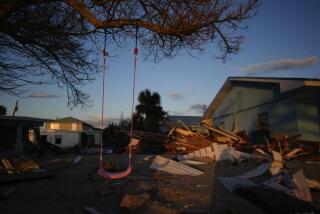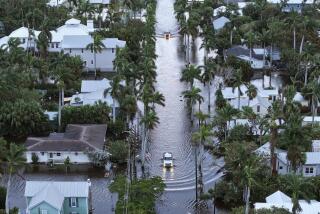‘Absurd amounts of rain’ as Florida is soaked for 5th day
FORT LAUDERDALE, FLA. — For the fifth straight day, Tropical Storm Fay threatened to soak Florida as if determined to end the state’s two-year drought in one swoop.
Three days after making landfall Monday in the Florida Keys and along the Gulf of Mexico, the lumbering storm crossed the coast for a third time Thursday afternoon near Flagler Beach and headed northwest.
Gov. Charlie Crist toured flooded and wind-damaged areas of Brevard County, including the community where a tornado damaged 51 homes Tuesday.
President Bush declared a federal state of emergency, opening the door for government help in dealing with the storm’s costs.
The storm reportedly claimed the lives of two swimmers Thursday afternoon -- an Indiana woman near Jacksonville and a New York woman at Daytona Beach.
Fay was dumping “absurd amounts of rain,” said state climatologist David F. Zierden at the Florida Climate Center at Florida State University.
Lake Okeechobee rose to 12.22 feet above sea level, and storm-water runoff was expected to push the lake closer to 13 feet, according to the South Florida Water Management District. At this time last year, the lake was 9.56 feet, and two years ago it was 11.99 feet. Normal is about 14 feet.
“Aside from the flooding, Fay has been beneficial for the water table,” district spokesman Randy Smith said.
Why so much rain?
“It is a slow-moving system” that has drawn moisture from the Gulf of Mexico and the Atlantic, Zierden said.
As the storm sat off the coast, many residents of Volusia, Brevard, Indian River and St. Lucie counties watched water rising over doorways, leaking through roofs and making streets hazardous.
State Insurance Commissioner Kevin McCarty said “several thousand” homes had been damaged by flooding. National Guard members helped evacuate some residents.
Power was out to about 10,000 homes and businesses early Thursday.
Wildlife officers were fielding calls about alligators, snakes and other creatures showing up in places they are not normally seen.
Officials say they receive more than 18,000 alligator-related complaints a year. But the floodwaters heighten the chance of an encounter. “They are trying to find dry land, someplace to hide,” Lenny Salberg of the Florida Fish and Wildlife Commission said.
--
This report includes information from the Associated Press.
More to Read
Sign up for Essential California
The most important California stories and recommendations in your inbox every morning.
You may occasionally receive promotional content from the Los Angeles Times.









